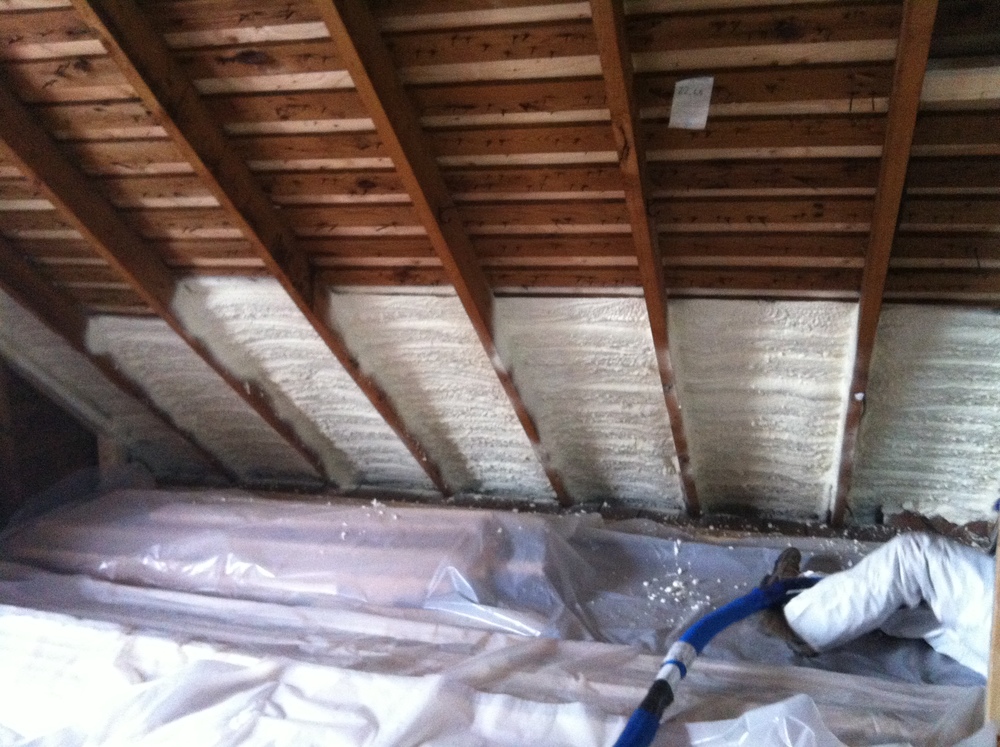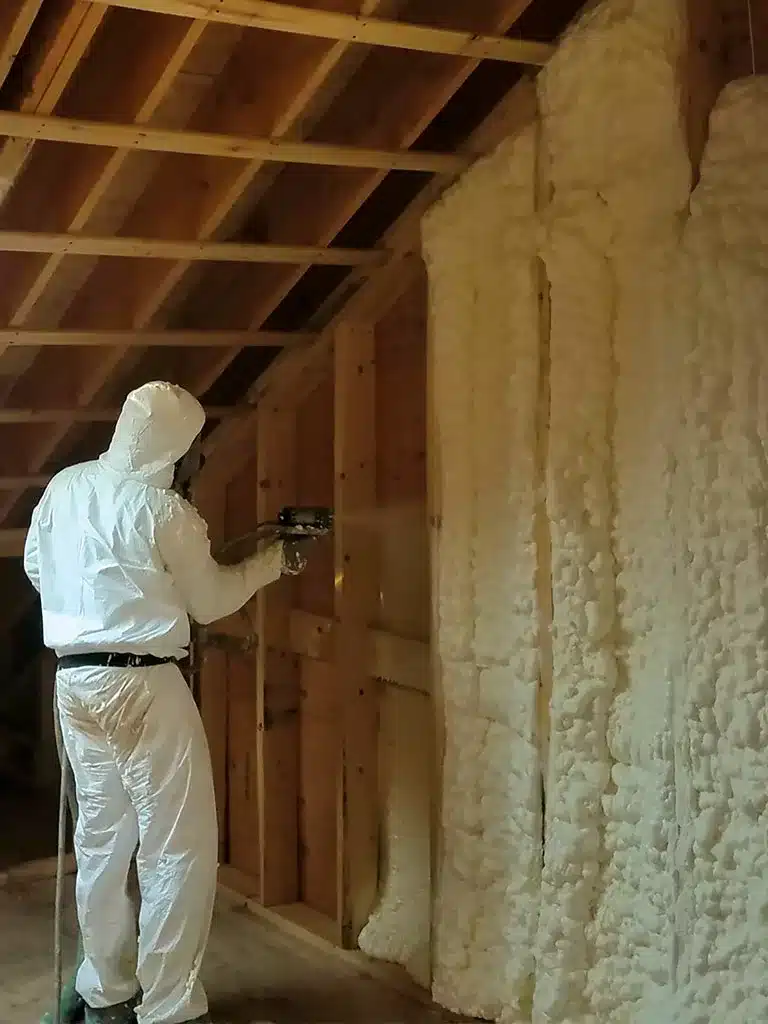The Environmental Impact of Spray Foam: Sustainability Considerations
The Environmental Impact of Spray Foam: Sustainability Considerations
Blog Article
Spray Foam: The Ultimate Solution for Air Sealing and Insulation
Spray foam insulation has actually arised as a leading option for efficient air sealing and thermal insulation, offering an unique mix of residential or commercial properties that set it apart from typical approaches. Comprehending the full scope of its advantages, installment processes, and comparisons with various other insulation kinds is important for making informed choices.
What Is Spray Foam?
Spray foam is a functional insulation material that combines the concepts of air sealing and thermal resistance to enhance power effectiveness in structures. Made up mainly of polyurethane or various other similar compounds, spray foam is used as a liquid that increases upon contact with surfaces, developing a solid, constant layer of insulation. This one-of-a-kind residential property enables it to load gaps, fractures, and gaps that typical insulation products might overlook, providing a remarkable air seal.
There are two main kinds of spray foam: open-cell and closed-cell. Open-cell spray foam is lighter and much more versatile, supplying superb noise absorption and a lower R-value per inch - Spray Foam. In comparison, closed-cell spray foam is denser, offering a greater R-value, moisture resistance, and included structural integrity to developing components
The application process typically includes specialized devices, making certain a seamless application that sticks to various substrates, consisting of concrete, steel, and timber. This adaptability makes spray foam appropriate for both brand-new constructions and retrofitting existing frameworks. Its capacity to create a closed obstacle significantly adds to minimizing power intake and improving indoor air high quality, therefore making it a preferred option amongst builders and property owners alike.
Benefits of Spray Foam Insulation
One of the most considerable benefits of spray foam insulation is its exceptional ability to create a continuous air barrier, which effectively reduces energy loss. Unlike conventional insulation materials, spray foam broadens to fill up fractures and spaces, making sure that air leakage is dramatically lowered. This particular not just boosts power effectiveness however likewise results in lower utility costs with time.
In addition, spray foam insulation gives premium thermal resistance, adding to a much more stable indoor setting. Its high R-value per inch enables efficient insulation in constrained rooms, making it suitable for attics, wall surfaces, and crawl rooms. Moreover, the moisture-resistant properties of spray foam aid stop mold and mildew development, promoting healthier living problems.
One more crucial advantage of spray foam insulation is its sound-dampening high qualities (Spray Foam). It effectively lowers noise transmission in between spaces, creating a quieter and a lot more comfortable home atmosphere. The sturdiness of spray foam also sticks out, as it does not sag or clear up in time, keeping its performance throughout its life-span
Exactly How Spray Foam Functions
Comprehending just how spray foam insulation functions is necessary for valuing its efficiency in air sealing and thermal resistance. Spray foam insulation is composed of 2 key elements: isocyanate and polyol material. When these components are blended, they undergo a chain reaction that triggers the product to expand quickly, developing a dense foam that fills voids, splits, and tooth cavities.
As the foam broadens, it follows surface areas, creating an airtight seal that substantially lowers air seepage. This characteristic makes spray foam insulation highly efficient at protecting against drafts and moisture penetration, which can result in energy loss and damage gradually. In addition, the closed-cell version of spray foam offers remarkable thermal resistance as a result of its rigid structure, effectively reducing warm transfer.
The special properties of spray foam allow it to comply with irregular surfaces, ensuring comprehensive coverage and a smooth obstacle. Consequently, spray foam insulation not just improves energy effectiveness but also contributes to boosted interior air top quality by minimizing the accumulation of contaminants and allergens. Ultimately, understanding the mechanics behind spray foam underscores its duty as a premium option for insulation and air sealing in both domestic and commercial applications.
Installment Process Review

Before installment, the space should be appropriately cleaned and prepped, making sure that surface areas are without dampness, particles, and dust. Due to the fact that impurities can compromise adhesion and overall performance, this step is important. As soon as the location is prepared, the application entails blending the 2 components of the spray foam, which broadens upon get in touch with and fills up spaces successfully.
Educated specialists need to perform the installment, making use of customized tools to make certain consistent insurance coverage and optimum thickness. Security safety measures, consisting of using protective gear and ensuring proper air flow, are important during this procedure. After application, the foam typically treatments promptly, creating a solid barrier that enhances power performance.
Comparing Spray Foam to Conventional Insulation
When examining insulation choices, spray foam insulation stands out in contrast to conventional products such as fiberglass and cellulose. Unlike fiberglass and cellulose, which can allow air infiltration, spray foam expands upon application, loading crevices and gaps to produce an impermeable why not try these out seal.
Furthermore, spray foam supplies a higher R-value per inch than typical insulation kinds, using more effective thermal resistance in a thinner profile. This particular is particularly advantageous in rooms with limited cavity depth. Spray foam is immune to dampness and mold development, which can be a substantial issue with cellulose and fiberglass, especially in moist environments.
Nevertheless, spray foam insulation typically carries a greater ahead of time cost than its conventional equivalents. Home owners must evaluate this first financial investment against long-term energy cost savings and efficiency advantages. Ultimately, while both insulation types serve their function, spray foam emerges as a much more innovative remedy for modern insulation needs, especially in terms of air sealing and thermal effectiveness.

Conclusion
In summary, spray foam insulation represents a highly reliable remedy for attaining optimum air securing and thermal resistance. Its special buildings, consisting of wetness resistance and noise dampening, make it appropriate for various applications in both new building and constructions and retrofitting tasks (Spray Foam). Although the first expenses may be higher contrasted to standard insulation products, the lasting advantages, such as significant energy financial savings and enhanced indoor air quality, warrant the investment and underscore its value in modern-day building practices.
Spray foam insulation has arised as a leading service for effective air securing and thermal insulation, offering an one-of-a-kind combination of residential or commercial properties that establish it apart from standard methods.Spray foam is a flexible insulation material that integrates the concepts of air sealing and thermal resistance to boost energy performance in buildings.When examining insulation options, spray foam insulation stands out in contrast to traditional materials such as fiberglass and cellulose. Inevitably, while both insulation types offer their objective, spray foam emerges as an extra advanced option for modern insulation requirements, specifically in terms of air sealing and thermal effectiveness.
In recap, spray foam insulation represents an extremely effective service for attaining optimum air sealing and thermal resistance.
Report this page